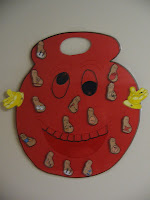Often, kids with physical disabilities do not have many opportunities
to engage in writing activities. There
are many ways to adapt activities to allow active participation in writing.
Here are some ideas to get your kids excited about writing: make a wish list
for Santa or a birthday, write a journal or online blog, write a story about an
imaginary place, write a funny poem, write an email to a friend, keep a
Facebook page updated.
Here are some ideas for vocabulary your student might use
when writing:
I want to write to….
|
Can you print this for me?
|
Let’s add a picture
|
I want to write more
|
Let’s send this in the mail.
|
I want to email
|
I want to write about...
|
Can you read it back to me?
|
This is a great story!
|
How do you spell…
|
What do you think of my work?
|
Let’s make a list
|
Can I check my email?
|
Let’s go to my Facebook page
|
Dear Santa,
|
Building A Story
- Try using symbols to create simple stories with a beginning, middle and end. Give your students the opportunity to choose from a selection of story starters, plots and conclusions. Below are some examples to get you started. Based on your student’s reading ability, you can choose to use symbols or just text. See additional examples in the “I Can” resource package attached.
- Try making multiple copies of the symbols/text. As a student makes a selection, provide them with a copy for them to paste on a paper. At the end, the student will have a hard copy of their story.
Story Starters
|
Story Plots
|
Story Conclusions
|
Once upon a time
|
a dragon breathed fire on all the land
|
and he was chased out of town and never seen again.
|
In a land far, far away
|
a princess found a frog
|
and everyone lived happily ever after.
|
One dark and stormy night
|
a monster was wandering the streets
|
and changed into a beautiful
unicorn.
|
In the middle of stinky wet swamp,
|
a caterpillar ate a monstrous mushroom
|
and sailed away across the ocean.
|
Make a Big Book
Have your older students create simple patterned
stories that are often used for young children. Provide an opportunity for your student to share this book with
younger students or show it off with their reading buddy.
No-Tech Ideas
- Fill in the story – Write simple sentences. Encourage your students to make choices to fill in the blanks. E.g. Michael likes to ______. (Swim/Eat/Drink/Dance/Jump)
Light Tech Ideas
- Try recording a story that your student has written onto a Step-by-Step™ communicator so that your student can re-tell the story to friends, family and others.
High Tech Ideas
- Students need access to a wide variety of vocabulary for writing. Often students who use a speech-generating device have only one word to express an idea or concept, e.g. “happy”. Give them access to a large and rich vocabulary bank. For example, instead of saying “happy” your student may want to say “excited”, “thrilled”, “elated”, “jumping for joy”, “energized”.
- Provide your student with vocabulary on their speech-generating device to allow them to meet their daily writing goals.
- Students may use adaptive software programs such as Intellitools Classroom Suite, Clicker, or Writing with Symbols. Check out the manufacturer’s website for an extensive list of activities to download.

